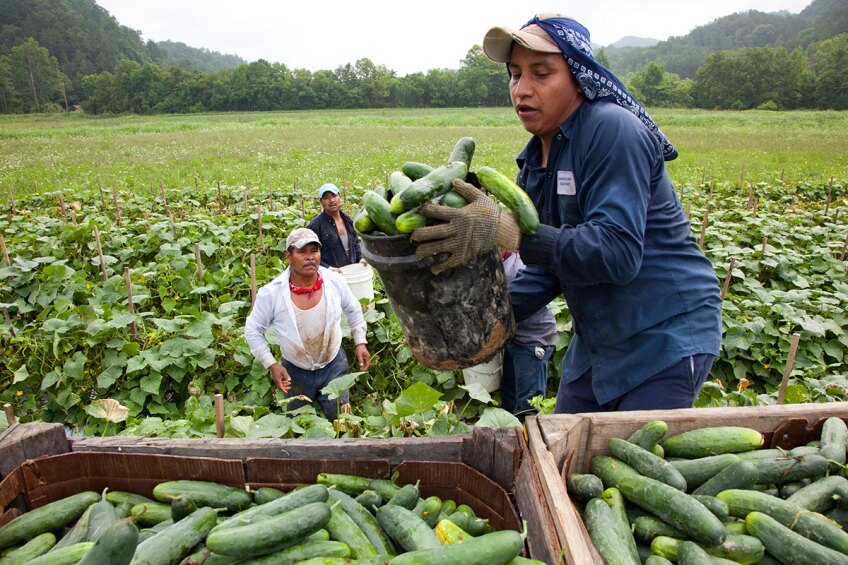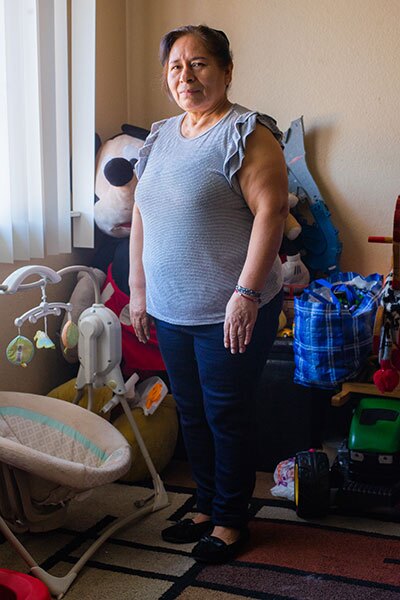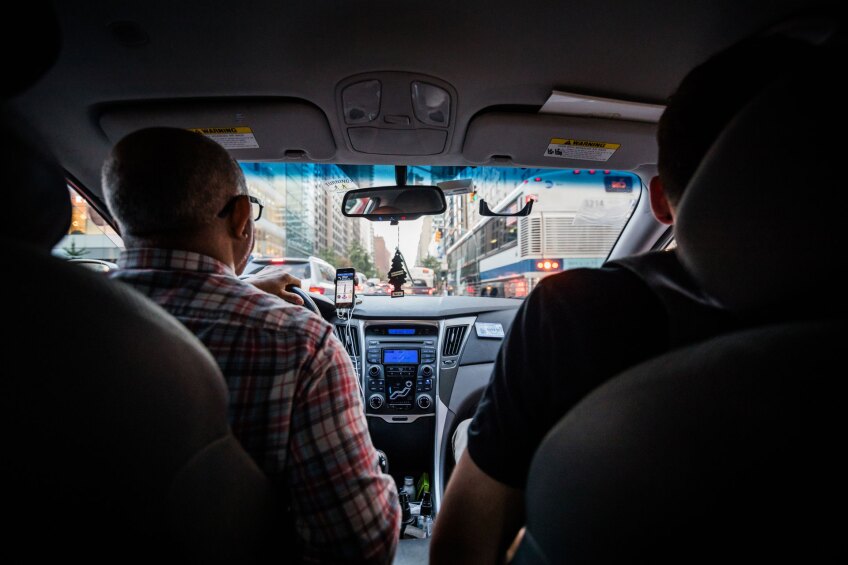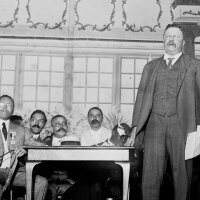The New Normal: Freelancing, Hustling and Informal Labor

This article is part 1 of a 4-part essay about the informal economy by Pascale Joassart, co-producer of "City Rising: The Informal Economy." Read Part 2, Part 3 and Part 4.
Definition: What is Informal Work?
The traditional employment contract, with long-term job security, benefits, and protections, has become a thing of the past for many workers. Today, as the middle class continues to disappear, a growing number of people make a living through alternative forms of work: freelancing, hustling on the side, and permanently temping. Some engage in side gigs after their day job ends or on the weekend to help make ends meet, but others work under the table full time as their sole source of income. Although these gigs can be considered illicit, since they break one or more laws in place, they are very rarely criminal. In fact, informal workers often perform the exact same tasks as formal workers, but they do so in an environment that is unregulated and unprotected. This violation or evasion of existing regulations and protections is the defining characteristic of informal work.
According to the International Labor Office, “informal employment now refers to all employment arrangements that do not provide individuals with legal or social protection through their work, thereby leaving them more exposed to economic risk than other workers.” This includes self-employed labor, like street vendors, nannies, and domestic workers, but also labor hired informally by large formal businesses, such as factory, farm and restaurant workers, truck drivers, and janitors. To be clear, drug trafficking, prostitution and other criminal activities are excluded from this definition of informal work that involves the production of legal goods and services in ways that may violate labor laws or reporting requirements.
A business or enterprise can be considered informal because it is not reported to appropriate government agencies or the owner failed to obtain the required permits – classic examples are street vending and domestic services. In other cases, however, the business is considered formal but the employment arrangement is informal because workers do not have a contract reflecting current laws or the one they have is not properly enforced – sweatshop labor comes to mind as an example, but there are many others including workers picking fruits for agricultural corporations, plumbers selling their work on street corners for established and licensed contractors, dishwashers working informally in well-known restaurants, and misclassified workers who are pushed into self-employment through sub-contracting. This type of work, which actually takes place in the formal economy, represents that vast majority of informal work in the United States and points to the complexity of distinguishing the formal and informal economy.

The lack of protection means that a central characteristic of informal work is risk. Under this type of work arrangements, it is the worker who bears any risk associated with working, including lost wages linked to getting sick or being injured, uncertainties tied to market fluctuations, costs of maintaining equipment, etc. It is not the employer, the corporation, or the state that takes on this responsibility. In other words, informal workers are highly vulnerable because they are not getting the benefits to which they would be entitled by law if they had a properly negotiated and enforced contract.
The lack of protection and the prevalence of risk represent a fundamental shift in the nature of work that is tied to the surge in inequality, precarity and insecurity experienced by a growing number of workers. The full extent of this transformation is not yet well understood and has been described by many different terms: the gig economy, the shared economy, the black market, the shadow economy, etc. Scholars and politicians debate whether informal work is a desperate survival strategy by the most marginalized workers or an entrepreneurial form of resistance against bureaucratic rules and heavy taxation. In fact, creative entrepreneurialism and horrific exploitation often exists side-by-side in the informal economy. Yet, there is overwhelming evidence that the expanding informal economy is mostly comprised of low-income workers who would prefer to work formally if they had the opportunity. This includes workers who are currently being drawn into the gig economy by its promise of flexibility and independence, but find themselves juggling multiple jobs and working long hours to stay afloat.

The New Normal: Informality and Insecurity
By definition, the informal economy is hidden and therefore difficult to measure. However, if we start paying attention, we will notice it everywhere – in many sectors of our economy from transportation to farming to personal services.
For regular folks, the economy is about putting food on the table, paying rent, maintaining our house, taking care of our children or older parents, getting to work, and having clean clothes to wear.
Informal work is not new. We have always had informal jobs in our economy, including street vending, farming, and domestic labor. Historically, these jobs were filled by immigrants, women, and people of color who faced discrimination and experienced significant obstacles in entering the formal economy. However, throughout the 20th century, most economists assumed that this type of work would eventually disappear as the economy grew, modernized, and became better regulated. In their eyes, the informal economy was perceived as a shrinking sector, leftover from a pre-modern or pre-capitalist mode of production, that was gradually being replaced by the modern formal capitalist economy. Today, this assumption is being called into question as people realize that the informal economy is actually growing and may indeed be an inherent part of capitalism, rather than a separate “sector” as scholars used to think.

Contrary to prediction, the informal economy has not dwindled, but instead is thriving and appears to be a permanent and pervasive feature of contemporary capitalism. For a few critical observers, the formal economy is just the tip of the iceberg: an abstract notion created by economists that reflects what can easily be measured by stock market indicators, employment statistics, income figures, etc. But for regular folks, the economy is much bigger and more tangible; it’s about putting food on the table, paying rent, maintaining our house, taking care of our children or older parents, getting to work, and having clean clothes to wear. And although some of these things can be purchased in the formal economy, they are often produced and obtained informally – off the books and under the table. In many ways, these everyday activities define who we are and form the basis of our social life. They constitute the gigantic and mostly invisible bottom of the iceberg that holds the tip above water.
While overlooked, the informal economy has been growing, especially during economic downturns like the Great Recession that hit our economy in 2008 and forced many people to consider different ways to make a living. Today, what economists refer to as the “informal economy” is worth well over $1 trillion, with estimates of its share of the Gross Domestic Product ranging between 5 percent and 20 percent, depending on how it is measured. According to a 2014 survey by the Federal Reserve, more than a third of the U.S. adult population had undertaken informal paid work either as a complement to, or as a substitute for, more traditional and formal work arrangements at some point during the 6 months preceding the survey. Similarly, a Government Accountability Office report on “contingent work” estimated its share of the 2010 U.S. employed labor force at 40 percent (up from 35 percent in 2006). Although contingent work – defined as temporary, part-time, on-call, and self-employment— is not necessarily informal, it is related to the extent that tends to be less regulated and protected than standard employment. Another recent study indicates that the percentage of workers engaged in “alternative work arrangements” – defined as temporary help agency workers, on-call workers, contract company workers, and independent contractors or freelancers – as their main job rose from 10.1 percent in February 2005 to 15.8 percent in late 2015. A striking implication of this study is that all of the net employment growth in the U.S. economy from 2005 to 2015 appears to have occurred in alternative work arrangements. In other words, the size of the formal economy did not increase during that period – staying around 125 million jobs, while the size of the informal economy grew by 9.4 million jobs from 14.2 to 23.6 million. The lack of creation of “good jobs” during the recent decade is a major reason for the increase in informality we are currently witnessing.
The lack of creation of “good jobs” during the recent decade is a major reason for the increase in informality we are currently witnessing... It is more than just a buffer in difficult times or a way to make a few extra bucks, it is the new normal for a growing share of workers.
These numbers are confirmed by the International Labor Office that estimates the share of informal employment in the U.S. at 18.6 percent of the employed workforce. While this is much lower than the 60 percent estimated globally, it represents a significant share of workers and a large number of jobs – over 20 million – for the world’s most powerful economy. In fact, the figure is higher in the U.S. than in most Western European economies where labor markets are more heavily regulated.
In short, the informal economy is a widespread, diverse, and complex network of communities, businesses and individuals engaging in work and consuming legal goods and services that are unregulated, unreported, and often untaxed. It is more than just a buffer in difficult times or a way to make a few extra bucks, it is the new normal for a growing share of workers.

The Evolution of Informality: New Technology and the Gig Economy
The history of labor policy reveals that labor markets have always been segmented, with some workers engaged in a parallel segment of the economy that is unregulated and therefore tends to be more exploitative. While historically, much of this occurred within the confines of existing laws in which loopholes permitted abuse and exploitation of certain groups, today the lowest segment of the labor market exists by ignoring and breaking enforceable laws, which have been established through great struggles over the past century. As the economy modernized and new laws were put in place to protect workers, prevent discrimination, and increase benefits, the informal economy was supposed to disappear. Instead, it seems to be growing, suggesting that, despite all these reforms, there are powerful tendencies and incentives to violate existing regulations to minimize labor costs. Informality needs to be understood as the most common contemporary form of labor exploitation, which persists in an economic system where many other forms have been ruled out by labor laws and workers’ protections. As such, it represents a failure of our legal and policy system.
People who sell crafts online, rent a room in their house, drive people in their own car, or provide other services through corporate electronic platforms are treated as independent contractors – not employees of these corporations... Consequently, they do not receive workers’ compensation insurance, job-protected leaves, health care benefits, and retirement benefits.
New terms have emerged in recent years, including gig, contingent, alternative, and precarious work to describe new work arrangements. Although they may not be exactly the same as informal work, they undoubtedly overlap and illustrate a general trend of informalization. The rapid expansion of the gig economy, in particular, reveals how technology may contribute to the casualization of labor, blurring the line between the formal and informal economy. Companies like Amazon, Etsi, Task Rabbit, Uber, etc. have mainstreamed informal work and freelancing. Not everybody agrees that these jobs are part of the informal economy since they are usually reported and taxed. However, there is a certain uneasiness among scholars about how they fit within the formal economy. For many observers, these jobs are “false self-employment” for “shadow corporations.” People who sell crafts online, rent a room in their house, drive people in their own car, or provide other services through corporate electronic platforms are treated as independent contractors – not employees of these corporations. Consequently, they bare most of the risk associated with working for those companies and do not enjoy the benefits and protections that workers in typical wage-based employer-employee relationships usually get. For instance, they do not receive workers’ compensation insurance, job-protected leaves, health care benefits, and retirement benefits. This is because our current safety-net was not designed for contingent and sub-contract work and needs to be updated. Despite narratives of entrepreneurship, sharing, and flexibility, the growth of gig work represents the widest expansion of precarious and casual labor since in the last 50 years. Young workers are particularly vulnerable to this trend, as suggested by evidence that almost half of millennials engage in freelance work, more than any previous generations.
These new developments challenge the idea that formal and informal activities are different from one another, in terms of industries, earnings, working conditions, geographies, etc. Instead, we now realize that formal and informal economies are so closely intertwined that many enterprises and jobs exist in a grey area between the two. Under these circumstances, it might be more useful to speak about a spectrum or degree of informality.
Top image: A young customer waits for his order at a hot dog stand on a busy street. | Still from "City Rising: Informal Economy"





